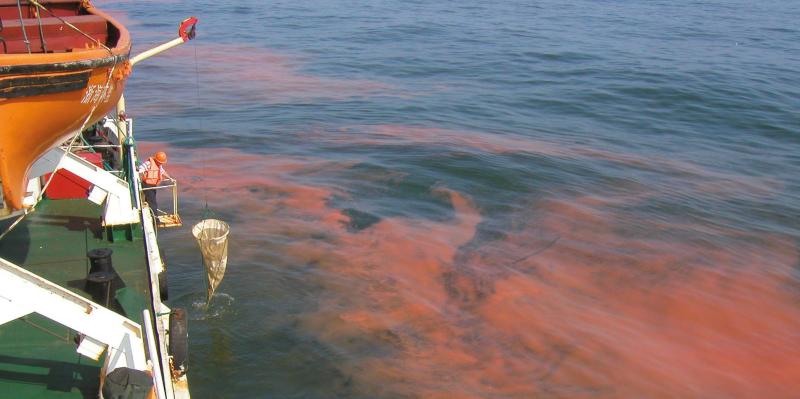Research innovations by IOCAS marine researchers build our understanding of marine ecosystem changes, ecological disasters, environmental pollution, corrosion, and other major ocean challenges.

A platform for managing marine ranches incorporates intelligent design. (Image by IOCAS)
Climate change and the pace of development are threatening marine ecosystems, which in turn, disrupts the marine-driven economy. From investigating the mechanisms underlying algal blooms, to developing techniques for ecological restoration, and slowing marine corrosion, scientists from the Institute of Oceanology, Chinese Academy of Sciences (IOCAS) seek to improve coastal ecosystems.
Found near coastlines of almost all oceans, jellyfish, congregated to form blooms, can lead to serious ecological damage, ruining beaches, reducing fishery production, and damaging coastal power plants. Yet, the main cause of the blooms is still unclear.
For IOCAS's Key Laboratory of Marine Ecology & Environmental Sciences, studies of blooms began with profiling the natural life history and population dynamics of jellyfish species, elucidating key processes and adaptive strategies. Extensive observation of giant jellyfish, Nemopilema nomurai, and two other species in the East China Sea and Yellow Sea has revealed key factors controlling their proliferation, such as water temperature and their food. The discovery of the root causes underlying jellyfish blooms provides technical support for risk evaluation, early warning and prevention of outbreaks that may damage coastal power plants and harm the tourism industry.
Similarly, when algae grow out of control to form blooms, they may pose harmful effects on people, fish and other coastal life. IOCAS researchers have studied red, green and brown tides along China's coasts, caused by high biomass of particular algal species. By analyzing biological features of these algae, and their distribution patterns, they have revealed the mechanisms underlying the formation of these algal blooms, and proposed prevention and control strategies.

IOCAS researchers are working in the field to study the red tides. (Image by IOCAS)
In seeking a low-cost, efficient strategy for mitigating red tides, IOCAS researchers have developed an innovative modified clay technology, which is ecologically safe. Finding that particle surface is key to determining the efficiency of this method, they have enhanced the positive charge of clay surface and increased interaction between clay particles and algal cells. This has dramatically improved the mitigation efficiency, avoiding the use of large amounts of less-efficient natural clays.
For large-scale applications, the research team has also developed spraying equipment and vessels for field operation, along with guidelines for emergency responses. The technology won the 2019 State Technology Innovation Award of China, and has been widely used in China and abroad, bringing significant socioeconomic benefits.
To address desertification of the sedimentary seabed and degraded coastal habitats in China, another key focus for IOCAS is developing techniques for marine ranching, or aquaculture, that are ecologically beneficial. For more than a decade, the team has worked on solving key technical problems in habitat restoration, resource conservation, monitoring and early warning systems.
Based on the ecological and physiological characteristics of key species, new technologies have been developed for the systematic construction of marine ranching infrastructure. For instance, by studying the life history, genetic diversity and composition of different eelgrass species, IOCAS researchers have revealed their evolutionary history, origin, and spread paths. They have also constructed seagrass seed banks, and enabled a seafloor seagrass transplantation technology that raises the success rate of germination by more than 20%, and the transplant survival rate by more than 30%.
Based on the sediment composition of different sea areas and behavioural characteristics of marine animals, a series of artificial reefs has been developed, which significantly increases carrying capacity and habitat space.
While restoration technologies facilitate ecological transformation, the assessment of the biological carrying capacity of marine ranches is just as important. To mitigate decreasing bio-resources caused by overfishing, an IOCAS team has developed technology to evaluate the capacity of five national marine ranching pilots. Based on a mutually beneficial mechanism in the stock enhancement ecosystem, they have designed optimal ratios of seafood species for different types of sea ranches, enabling diverse structures for bio-communities.
IOCAS researchers have also built monitoring platforms to measure how bio-resources respond and adapt to environmental change, enabling a system for comprehensive ecological evaluation, forecast and warning. Their research on the response mechanisms of sea cucumbers, for instance, reveals how they adjust to extreme environmental conditions, like high temperature, or low oxygen, via behavioural, physiological, metabolic and gene regulation changes.
Based on the results, systems are designed for biological, climate and environmental data monitoring. The technology has been used in the Yellow and Bohai Seas, leading to improved water quality, increased economically valuable species, and a resource volume more than seven times bigger for marine ranches.
With a model for collaboration between research institutes, enterprises, and fishermen, IOCAS research results have vastly improved marine ranching and coastal ecology, boosting fishing income and economic profits for relevant industries.

